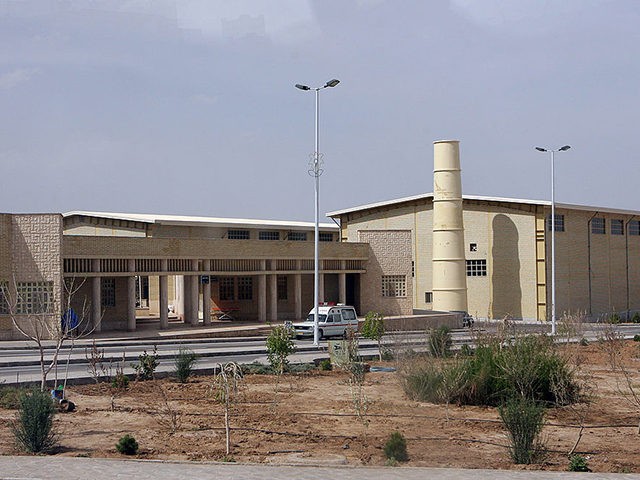Iranian officials insisted on Thursday that a mysterious fire at the Natanz nuclear facility was not an act of “intentional sabotage,” although they also stated the “incident” was still under investigation, and felt it necessary to throw in a belligerent warning to “hostile countries” that Tehran will retaliate if anyone crosses its “red lines in any way.”
Iran’s state-run PressTV quoted an unnamed security official who said there was no evidence of sabotage behind the fire, which the Atomic Energy Organization of Iran (AEOI) described as inflicting only minor damage on a shed that was still under construction, with no injuries or delays to operations at the facility.
An AEOI spokesman said the full extent of the damage was still under assessment but insisted there was no radioactive material stored in the area affected by the fire.
“We have many open-space sheds at Shahid Ahmadi Roshan enrichment complex. Our enrichment activities are mostly done underground,” spokesman Behrouz Kamalvandi said.
“Our activities are being carried out without stoppage and in the best possible form in this important facility and enrichment of material continues,” he added.
Kamalvandi denounced reports of possible radioactive contamination from the fire as “false propaganda by enemy and counterrevolutionary media.”
Contrary to these assurances, video clips and photos are flowing online that show a building at the Natanz site suffered heavy damage, including evidence of an explosion from inside the structure that was strong enough to blow off exterior doors and severely damage the roof. Before hammering out its new narrative about a slightly-cooked partially-completed empty shed, the AEOI itself put out some photos that showed a large and solid structure that suffered severe fire and explosion damage.
Also contrary to the line from the AEOI, Radio Farda quoted outside experts who said the building depicted in those blast- and fire-damage photos is the uranium centrifuge assembly center at Natanz, not some half-empty storage shed.
“It would delay the advancement of the centrifuge technology quite a bit at Natanz. Once you have done your research and development, you can’t undo that research and development. Targeting them would be very useful,” Fabian Hinz of California’s Middlebury Institute observed.
Hinz also disputed Iran’s characterization of the fire as a minor accident, describing it as “very, very suspicious.”
The Associated Press reported on Friday that a previously unknown Iranian dissident group calling itself “Cheetahs of the Homeland” is circulating an online video claiming responsibility for the Natanz fire, plus other attacks the Iranian government has been covering up.
The group also sent emails to foreign media that claimed its membership includes “soldiers from the heart of the regime’s security organizations” and its goal is to stop the regime from acquiring a nuclear weapon.
“The video and one written statement also referred to Supreme Leader Ayatollah Ali Khamenei as ‘zahhak,’ a monster in Persian folklore. But the tone across the messages clashed, with one using terminology often associated with Iran’s Mujahedeen-e-Khalq exile group and the video seemingly showing Iran’s Shiite theocracy as worse than the rule of Shah Mohammad Reza Pahlavi. The video also included part of the nationalist song ‘Ey Iran,’ which reformists and opposition groups both sing,” the AP noted.
The AP further quoted some observers who pointed out that Iran’s national soccer team is nicknamed the “Cheetahs,” so it would seem like an odd choice for the name of an insurgent strike force. Those observers clearly have never seen the movie Red Dawn.
Skeptics nevertheless assumed the “Cheetahs of the Homeland” video was cover for an operation more likely carried out by a foreign agency such as Israel’s Mossad. A possible clue is that the “Cheetahs” video refers to the nuclear facility as “Kashan” rather than “Natanz,” using the name of a nearby city that was once home to a large Jewish community.
Despite its insistence that the fire was a minor accident with no evidence of deliberate sabotage, the Iranian regime on Thursday issued a belligerent warning through state media that “if there are signs of hostile countries crossing Iran’s red lines in any way, especially the Zionist regime and the United States, Iran’s strategy to confront the new situation must be fundamentally reconsidered.” The “Zionist regime” was a reference to Israel.
The Natanz fire occurred only a few days after a massive explosion lit up the sky over Tehran. The official explanation for the blast was a gas tank detonating in a public area near the Parchin nuclear facility.
Natanz was also the site of a confrontation in November 2019 in which an inspector working for the International Atomic Energy Agency (IAEA) was prevented from performing her duties, harassed, and briefly placed under arrest by Iranian authorities, supposedly because they suspected her of carrying “suspicious material.”
The U.N. and European Union joined the United States in denouncing Iran for interfering with inspectors at the Natanz site, which houses Iran’s primary uranium enrichment facility. Iran is currently violating the nuclear deal, formally known as the JCPOA, by using the centrifuges at Natanz to enrich uranium to higher levels than allowed by the agreement, although it is not believed to have reached weapons-grade enrichment yet.

COMMENTS
Please let us know if you're having issues with commenting.